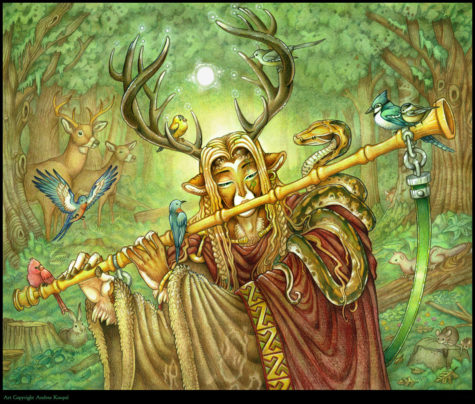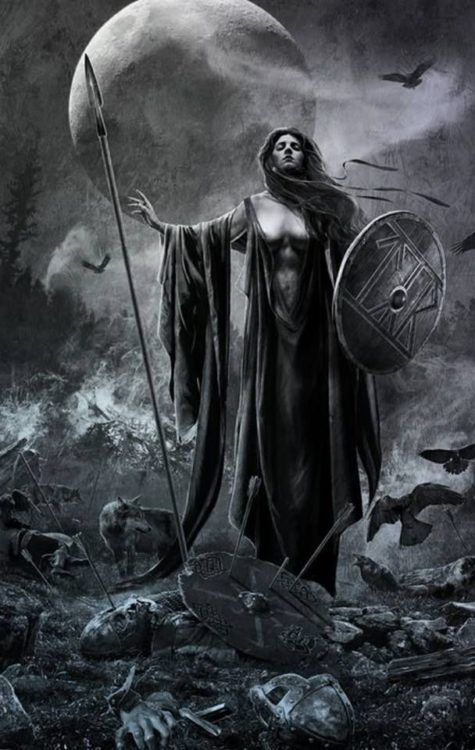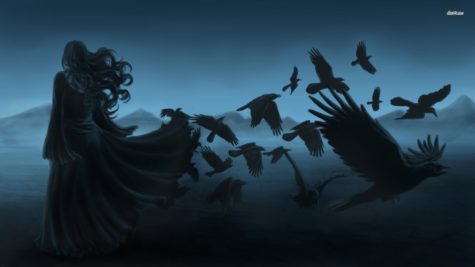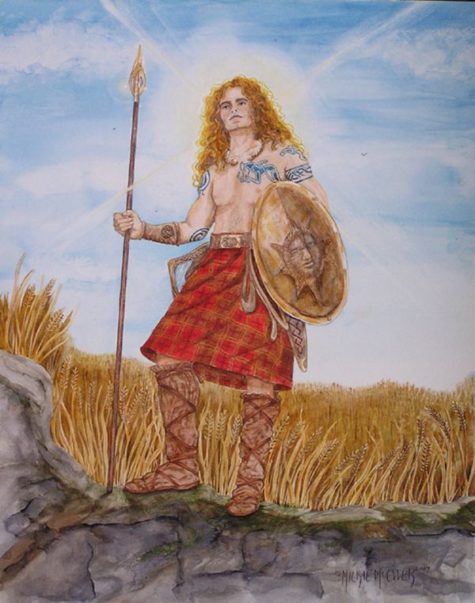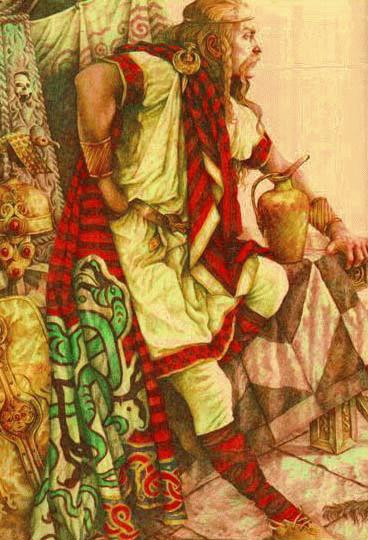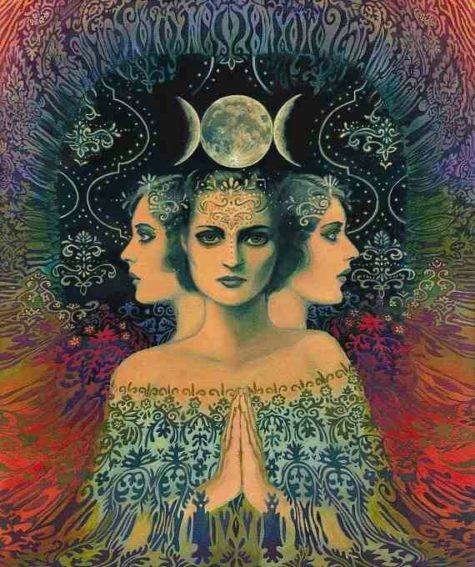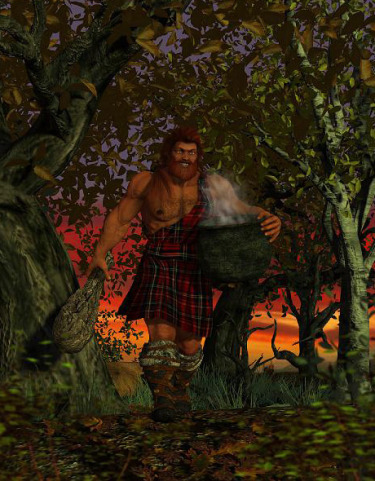Celtic Gods and Heroes
Below are listed some of the animals denoted by Celtic Shamanism and Druidism along with their spiritual denotation:
Adder, Snake (Nadredd):
The snake has long been associated with wisdom, reincarnation, and cunning. The Poisonous adder of the British Isles has the same reputation. Although there were no snakes in Ireland, the Irish Celts knew about them. The Druids were known in Wales as Nadredd. The Druids also carried an amulet called gloine nathair (Serpent Glass); which was supposed to be formed from the eggs of an adder.
Badger (Breach):
This animal is unyielding in the face of danger and is noted for its tenacity and courage. In the Welsh tale of Pwyll’s courting of Rhiannon, a badger is mentioned as a guide during dreaming. The badger will teach you to fight for your rites and defend your spiritual ideas.
Bat:
Associated with the underworld or Awwyn, as the bats radar guides it through the night avoiding obstacles and barriers, so it can teach you to do the same.
Bear (Arth):
Although the bear was native to the Isles, it is now extinct there. The word Arth, means bear, which is the root word for the name Arthur. The bear was noted for its strength and stamina. It is said to help give you balance in life and the strength to do what is necessary.
Bee (Beach):
The bee is revered as industrious, single minded when performing a task, and fearless when defending its home.
Blackbird (Druid-dhubh, Lon Duhb):
Legends say that the birds of Rhiannan are three blackbirds, which sit and sing in the World Tree of the Otherworlds. Their singing puts the listener into a sleep or a trance which enables him/her to travel to the Otherworld. It was said to impart mystic secrets.
Boar (Bacrie):
Important in the arts and myths of the Celtic people, the boar was known for its cunning and ferocious nature. A famous legendary boar was Orc Triath, which the goddess Brigit owned. In the Arthurian tales of the Mabinogion the boar Twrch Trwyth was a terrible foe to Arthur. The White Boar of Marvan sent inspiration to its master to write music and poetry.
Bull (Tarbh):
A common animal figure in Celtic mythology, the bull symbolizes strength and potency. Certain divination rituals required the sacrifice of a white bull. In the tale of the Tain Bo Cuailgne (Cattle raid of Cooley), two special bulls are coveted by two rulers. The Tar-roo-Ushtey (Water bull) is said to haunt the Isle of Man.
Butterfly:
In many cultures the butterfly is thought to be the souls of the dead and keepers of power. There is said to be no negative energies experienced in any Otherworld area when there is the presence of butterflies. It is said that they will help you to view matters with greater clarity.
Cat (Caoit, Cat):
Many of the Celtic legends picture the cat as a ferocious, evil creature, but that may have been because cats at that time were untamed. In Ireland Finn mac Cumhail was said to have fought a clan of “cat-headed” people. The cat is a strong protector, especially when placed in confrontation.
Cock:
In several Celtic legends the cock chases away ghosts and unwanted spirits by his crowing at dawn. It represents the power of the word to dispel negativity.
Cow (Bo):
Once so important to the Celts it was used as a form of currency or monetary exchange. Ancient Irish lords were known as bo-aire or cow-lord. The cow was sacred to the goddess Brigit. The cow symbolizes contentedness, defending the inner child, and providing for daily needs.
Crane:
At one time the crane was a common animal in the British Isles. One later Celtic tradition, apparently originated after the arrival of Christianity, is that cranes are people who are paying a penance for some wrong doing. The crane is associated with the Cailleach and Manannan Mac Lir, who made his crane bag from its skin. The crane with its colors of black, white, and red, was a moon bird, sacred to the Triple Goddess. Magick, shamanic travel, learning and keeping secrets, reaching deeper mysteries and truths is said to be taught by the crane.
Crow (Badb):
This animal is to be treated with care. Along with the raven, the crow is a symbol of conflict and death, an ill-omen associated with such Goddess as Macha, Badb, and Morrigan. The Irish word for crow is badb, which is also the name of a Celtic war Goddess. Although the crow was ill-omened, it was also considered to be skillful, cunning, and a bringer of knowledge. It teaches you to learn from the past, but not to hold onto it. It is of most value when trickery is in need.
Deer (Abhach) or Stag (Sailetheach):
In its form of the white doe or white stag, the deer was often a messenger and guide from the Otherworld. Following such an animal led the unsuspecting human into contact with supernatural beings. The antlered headdress of Cernunnos is a symbol of the stags stature. The deer represents keen scent, grace, swiftness, and gentleness. These are the ways of reaching our goals without using force.
Dog (Abach, Mada) or Hound (Cu):
Devoted hounds are often mentioned in Celtic myth, such as Bran and Sceolan which belonged to Finn mac Cumhail. Underworld hounds, such as the Welsh Cwn Annwn belonged to Arawn, are always white with red ears. The Underworld Hounds run down and punish the guilty. Dogs represent tracking skills, the ability to scent a trail, and companionship.
Dolphin:
This creature was associated with the sea deities. It deals with dreams and harmony, and recognizing and balancing the rhythms of your body with those of nature.
Dragon (Piastras, payshtha, Horn):
The dragon in Celtic-British mythology has more varieties than the standard legged form; it is sometimes represented as a water serpent or worm-shaped beast. There are many references to serpents or dragons in Celtic myth. On many occasions the Fianna fought huge dragons in lakes. Most cultures consider the dragon a benevolent dweller of caves, lakes, and the inner Earth. It was an ancient symbol of wealth. The dragon symbolizes the power of the Elements, especially that of the Earth, but also of the treasure of the subconscious mind.
Eagle (Lolair):
A bird noted for wisdom and long life in Celtic stories. The eagle represents swiftness, strength, keen sight, and the knowledge of magick. It helps you to see hidden spiritual truths.
Eel (As-chu):
One of many stories in which the eel is mentioned is the story of the swineherds who battled through a variety of shape-shifting forms. In their final forms as eels, the swineherds were swallowed by cows who later gave birth to magickal bulls. Cu Chulainn’s spear Gae-Bolga got its name from the eel. The eel symbolizes adaptability, wisdom, inspiration, and defense.
Fox (Mada Rua):
In Taliesin’s Song of His Origins, the Bard says he assumed the shape of a satirizing fox, a reference to the cunning, slyness, and ability of the fox to make fools out of those who chase it. The ability to watch the motivations and movements of others while remaining unobserved is the skill which we may learn from the fox.
Frog:
In many cultures the frog is a symbol of magick. It can teach you to leap swiftly from one level of consciousness to another, from this world to the Otherworld. The frog can also help you find the courage to accept new ideas, nurture yourself, and find connections between ideas.
Hare or Rabbit (Coinin):
An animal sacred to the Goddess Andraste in particular. Its movements were sometimes used for divination; Boudicia used a hare this way just before her last battle with the Romans. It is associated with transformation, the receiving of hidden teachings, and intuitive messages.
Hawk (Aracos):
Celtic oral tradition lists the oldest animal as the Hawk of Achill. As with other birds, the hawk is a messenger between the Otherworld and this world. However, it is of greater skill and strength than other birds. It symbolizes clear sightedness and longevity of the memory. If you hear a hawk cry during a journey, be alert to upcoming situations that need boldness and decisiveness to keep from being thrown off balance.
Horse (Cab-all, Capall):
A popular animal of the Celts. Sacred to the Goddesses Epona and Rhiannon. The horse was considered to be a faithful guide to the Otherworld. It symbolizes stamina, endurance, and faithfulness.
Lizard:
The lizard symbolizes the shadowy plane of manifestation where events are constantly changing shapes and patterns. If you see a lizard on a journey, be alert to all below the surface activities going on around you.
Lynx:
This creature is considered the keeper of deep secrets and hidden knowledge. It can help with divinatory skills and the development of psychic senses. Sometimes it symbolizes the need to look deeper within yourself to see that which is often hidden.
Magpie:
This bird is said to deal with omens and prophecies, as well as the mysteries of life and death.
Mouse (Luch):
The mouse is often mentioned in Celtic folklore. In a Welsh story with Manawydan and Pryderi, a mouse is portrayed as the shape shifted wife of the magician Llwyd. The mouse represents secrets, cunning, shyness, and the ability to hide in times of danger.
Otter (Balgair):
These animals were considered very magickal by the Celts. Otters were said to appear and help during the voyages of Maelduine, Brendan, and others. The otter is a strong protector who helps with gaining wisdom, finding inner talents, faithfulness, and the ability to recover from any crisis.
Owl (Caillech):
These birds were most often associated with the Crone aspects of the Goddess. The word “cailleach” in the Scottish Gaelic means “owl.” The owl is often a guide to and through the Underworld, a creature of keen sight in darkness, and a silent and swift hunter. It can help unmask those who would deceive you or take advantage of you.
Pig (Muc):
A swine was considered to be the magickal, sacred food of the Tuatha De Dannan and an animal of Manannan mac Lir. In the Mabinogion Pwyll received a gift of pigs from the underworld God, Awrawn. Their later theft by Gwydion caused the death of Pwyll’s son Pryderi. The writings of Merlin say that he spoke with a little pig in visions. Symbolic of the spiritual food necessary to the Druids who were said to be swine herders.
Rat (Francach):
Rats are not mentioned in a favorable light in Celtic folklore, but they have their place. Rats are sly, sometimes aggressive, creatures who can track down whatever they seek, defending themselves ferociously.
Raven (Bran):
Take care when dealing with this bird. An important animal of the Celts. In Ireland the raven was associated with the battlefields and such Goddesses as Morrigu or the later Welsh Morrigan, just as the crow. The bird was connected with Bran the Blessed. In Welsh, bran means, “raven.” Although its reputation is dubious, it is an oracular bird. It often represents the upsets and crisis of life that are necessary for new creation.
Salmon (Brionnfhionn):
A very wise, magickal creature in Celtic lore. A salmon of great knowledge is said to swim in the Well of Segais, eating the mystical hazelnuts that fall into the well. When the Irish hero Finn mac Cumhail burned his thumb on a salmon and then put the thumb in his mouth, he gained shamanic knowledge. The salmon teaches how to get in touch with ancestral knowledge and how to put it to practical use.
Sow (Airc):
The Goddess Cerridwen was known as the White Sow. The sow was considered a very powerful creature in the Underworld. As a creature of Cerridwen, it was associated with the Sacred Cauldron and the granting of inspiration; also a creature of death and rebirth.
Squirrel:
This creature is always preparing for the future; it is said to have shown the druid how to do this in a practical way. Sometimes its appearance heralds changes, even adversities. Plan ahead so that you may always be prepared.
Swan (Eala):
A mystical bird who finds its way into several Celtic stories. Its feathers were often used in the ritual cloak of the Bards. Swans are connected with music and song. Swans also help with the interpretation of dream symbols, transitions, and spiritual evolution.
Turtle:
The turtle is a slow moving, methodical creature, carrying its protection constantly with it. It is said to teach the druid to be grounded, how to stay in tune with Earth energies, the wisdom of flowing with the cycles of life, and to be gentle with the body’s needs.
Unicorn:
This mythical Celtic creature had the body of a white horse, the legs of an antelope, tail of a lion; and a single horn on its head. It is the symbol of supreme magickal power. It teaches that every action is creation, so make every day count.
Wolf:
The wolf is a cunning, intelligent creature, capable of out thinking hunters. It can teach you how to read the signs of nature in everything, how to pass danger invisibly, how to outwit those who would wish you harm, and how to fight when needed.
Wren (Dryw, Dreoilin):
A sacred bird to the Druids specifically, its musical notes were used for divination. As with many other birds, the wren was considered a messenger from the deities.
Source: Father Oak
- Also known as: Morrigu, Morrigna
- Origin: Ireland
- Birds: Corvids: Crow, Raven, Roo
- Creatures: The Morrigan owns a herd of enchanted magickal cattle
- Color: Red
- Day: Samhain
The Morrigan is a Celtic goddess of battle, strife, and fertility. Her name translates as either “Great Queen” or “Phantom Queen,” and both epithets are entirely appropriate for her. The Morrigan appears as both a single goddess and a trio of goddesses.
The Morrigan is a powerful spirit of birth, death, sex, destruction, and fertility. She is among the goddesses associated with Ireland’s well-being and sovereignty. Her name is variously translated as:
- Great Queen
- Sea Queen
- Phantom Queen
- Terrifying Queen
She is an oracular, prophetic spirit who can reveal the future and anyone’s destiny – that is, if she feels like it. The Morrigan is a headstrong, passionate goddess who does as she pleases. She is among those goddesses serving as Washers at the Ford
The Morrigan may be one spirit, a triple goddess, or three manifestations in one. The Morrigan may name a triad of distinct goddesses – usually Badbh, Nemain, and Morrigan, but sometimes Macha is included.
The Morrigan is most famous as a war goddess. She may instigate battle or meddle with it. The concept of minding her own business does not exist: Battle is her business. Anything that captures her interest is her business. The Morrigan is also renowned for giving sound battle advice. She advised the Dagda on how to deal with the fumorians.
The Morrigan determines war’s outcome, bestowing victory to whichever army or warrior she favors, but she has a reputation for being capricious. Her favors can never be taken for granted. Her frenzied war fury unnerves armies. Her shriek is deadly.
The Morrigan frequently appears in the ornithological guise of a hooded crow. She is one of the Tuatha Dé Danann (“Tribe of the goddess Danu” or the land of the Faries) and she helped defeat the Firbolg at the First Battle of Mag Tuireadh and the Fomorians at the Second Battle of Mag Tuireadh. She is often read about in books that are about the Fae.
Her many manifestations include, but are not limited to:
- A beautiful woman
- A hag.
- A crow
- A deer (doe or stag)
- A white heifer with red ears and no horns
- A black eel long enough to coil three times around the legs of Cu Chulain, a great man.
She appeared to the hero Cu Chulainn (son of the god Lugh) and offered her love to him. When he failed to recognize her and rejected her, she told him that she would hinder him when he was in battle. When Cu Chulainn was eventually killed, she settled on his shoulder in the form of a crow. Cu’s misfortune was that he never recognized the feminine power of sovereignty that she offered to him.
She appeared to him on at least four occasions and each time he failed to recognize her.
- When she appeared to him and declared her love for him.
- After he had wounded her, she appeared to him as an old hag and he offered his blessings to her, which caused her to be healed.
- On his way to his final battle, he saw the Washer at the Ford, who declared that she was washing the clothes and arms of Cu Chulainn, who would soon be dead.
- When he was forced by three hags (the Morrigan in her triple aspect) to break a taboo of eating dog flesh.
More than just a battle goddess, the Morigan is also a goddess of life, birth, and sex. She is sometimes identified as a mermaid. On Samhain, the beginning of the Celtic dark half of the year, the Morrigan stands astride a river with one foot on either bank to engage in the Great Rite – sacred, transformative, ritual sex – with the Dagda (Ireland’s All-Father).
Sources:
- Redbubble
- The Encyclopedia of Spirits
Lugh (pronounced LOO) was known to the Celts as a god of craftsmanship and skill — in fact, he was known as the Many-Skilled God, because he was good at so many different things. In one legend, Lugh arrives at Tara, and is denied entrance. He enumerates all the great things he can do, and each time the guard says, “Sorry, we’ve already got someone here who can do that.” Finally Lugh asks, “Ah, but do you have anyone here who can do them ALL?”
- Origin: Celtic
- Attributes: Magical spear, harp
- Bird: Raven
- Animal: Lion, horse
- Planet: Sun
- Plant: Red corn cockles
Lugh, Lord of Craftsmanship, Light, Victory and War, is a master builder, harpist, poet, warrior, sorcerer, metalworker, cupbearer and physician. It’s hard to envision anything at which Lugh does not excel.
- Also known as:
Lug, Luc, Lugos, Lleu Llaw Gyffes, Bright One of the Skillful Hand - Favored people:
Artisans, crafts people, poets, artists, physicians, soldiers, and warriors. - Manifestation:
Shining, handsome, charming and witty. He has a silver tongue to match his skillful hands. - Consorts:
Lugh has different consorts in different locations but he was frequently linked to Rosemerta. - Spirit Allies:
Lugh shared the city of Lyon with Kybele and Paris with Isis. In battle, Lugh used his own weapons but also those belonging to Manannan.
Lugh was venerated throughout the ancient Celtic world. Modern scholars perceive him as especially significant because his veneration indicates the existence of pan-Celtic spiritual traditions. (Celts once ruled a huge swathe of continental Europe before being forced to the very edges of the continent.)
At least fourteen European cities are named for Lugh including Laon, Leyden, Loudon and Lyon. Lyon’s old name was Lugduhum, meaning “Lugh’s Fort.” Tat city is believed to have been his cult center. Its coins bore the images of ravens which may be a reference to Lugh. Carlisle in England, the former Lugubalium, is also named in Lugh’s honor. Some theorize that Lugh’s name is reflected in an older name for paris: Lutetia.
The Romans identified Lugh with Mercury. Many European churches dedicated to Michael the Archangel are believed to have been built over sites once dedicated to Lugh. Post-Christianity many of Lugh’s sacred functions were reassigned to saints like Patrick and Luke.
Lugh apparently traveled westward through Europe. Irish and Welsh myths describe his first appearance in their pantheon. He is greeted with resistance from women in Wales. His first public act in Ireland is to join battle with the Tuatha De Danaan (his father’s people) against the Fomorian, his mother’s people. Lugh chooses allegiance with the paternal line; the myth may be interpreted as indicating the beginnings of patriarchy in Ireland.
- Feast: August 1st
August 1st is the festival of Lughnasadh. Lughnasadh (sometimes spelled Lughnasa) means “the marriage of Lugh.” Lugh the sun and the Earth Mother renew their wedding vows annually during the full moon in August and invite all to gather and revel with them. Lughnasadh celebrates the consummation of their sacred relationship.
Once upon a time, Lughnasadh was a four week festival.: the last two weeks of July and the first two weeks of August, roughly corresponding to when the sun is in Leo, the astrological sign that belongs to the sun and epitomizes its power. In modern Irish Gaelic, the month of August is Lunasa. However the modern Wiccan sabbat of Lughnasadh is almost always devoted solely to the eve of July 31 leading into Lughnasadh Day on August 1st.
Celebrating Lugh Today:
Lughnasadh is a pagan holiday is dedicated to this capable God, and is celebrated every year on August 1st.
Take the opportunity this day to celebrate your own skills and abilities, and make an offering to Lugh to honor him, the god of craftsmanship.
Here’s How:
Before you begin, take a personal inventory. What are your strong points? Everyone has a talent — some have many, some have one that they’re really good at. Are you a poet or writer? Do you sing? How about needlecraft, woodworking, or beading? Can you tap dance? Do you cook? How about painting? Think about all the things you can do — and all of the things you’d like to learn to do, and the things you’d like to get better at. Once you sit down and think about it, you might be surprised to realize how accomplished you really are.
Decorate your altar with items related to your skill or talent. If your skill relates to something tangible, like sewing or jewelry-making, put some of your craft supplies on the altar. If it’s an ability to DO, rather than MAKE, such as dancing or singing, put some symbol of your ability on your altar. Do you have a favorite outfit you wear when you dance? A particular song lyric that you know you’re fabulous with? Add as many items as you like to your altar.
You’ll need a candle to symbolize Lugh, the god. Any harvest color is good, because he came up with the idea of a grain festival to honor his foster mother, Tailtiu. Place the candle on your altar in the center. Feel free to add some stalks of grain if you like — you can combine this rite with one honoring the harvest, if you choose.
Light the candle, and take a moment to think about all the things you are good at. What are they? Are you proud of your accomplishments? Now’s your chance to boast a little, and take some pride in what you’ve learned to do.
Announce your own talents in the following incantation. Say:
Mighty Lugh, the many-skilled god,
he who is a patron of the arts,
a master of trades, and a silver-tongued bard.
Today I honor you, for I am skilled as well.
I am deft with a needle,
strong of voice,
and paint beauty with my brush strokes.*
*Obviously, you would insert your pride in your own skills here.
Now, consider what you wish to improve upon. Is your tennis-playing out of whack? Do you feel inadequate at bungee jumping, yodeling, or drawing?
Now’s the time to ask Lugh for his blessing. Say:
Lugh, many-skilled one,
I ask you to shine upon me.
Share your gifts with me,
and make me strong in skill.
At this time, you should make an offering of some sort. The ancients made offerings in exchange for the blessings of their gods — quite simply, petitioning a god was a reciprocal act, a system of exchange. Your offering can a tangible one: grain, fruit, wine, or even a sample of your own talents and skills — imagine dedicating a song or painting to Lugh. It can also be an offering of time or loyalty. Whatever it is, it should come from the heart.
Say:
I thank you, mighty Lugh, for hearing my words tonight.
I thank you for blessing me with the skills I have.
I make this offering of (whatever it is you are offering) to you
as a small token of honor.
Take a few more moments and reflect on your own abilities. Do you have faith in your skills, or do you deflect compliments from others? Are you insecure about your abilities, or do you feel a surge of pride when you sew/dance/sing/hula hoop? Meditate on your offering to Lugh for a few moments, and when you are ready, end the ritual.
Tips:
If you are performing this rite as part of a group, family or coven setting, go around in a circle and have each person take their turn to express their pride in their work, and to make their offerings to Lugh.
Sources: Encyclopedia of Spirits and PaganWiccan
The Three Mothers, or Triple Goddess, were known around the world. The Triple Goddess represented the three stages of human life: youth and puberty, parenthood and maturity, old age and wisdom; or body, mind, and spirit. This triad symbolizes the three phases of the Moon: Crescent, Full, and Dark. The goddesses were most often known by the titles of Maid, Mother, and Crone. The ancient Mystery schools, which were originally centers of Goddess knowledge, had three main steps or degrees.
The number three was a sacred number from the time of the ancient Babylonians on. Pythagoras wrote that the Universal Order had to manifest itself in threes. The ancient Chinese thought that three engendered all things. Even today, in numerology the number three stands for activity, creativity, talent, and knowledge.
The Celtic countries, in particular, honored this triad as the bringer of prosperity and a good harvest. The Celts considered the Horned God of the Forests to be Her consort and help-mate. During the month of May, especially at the ceremony of Beltane, wearing of the color green and freely expressing themselves sexually was widely practiced by the Celts. This practice became a real headache for the Christians when they took over. They tried to curb this custom by declaring that the color green was unlucky ant that sex was sinful and dirty.
We can look at the Three Mothers as more than sexual activity. They are symbols of the cycles of growth upon the Earth, the phases we physically go through in our present life, cycles of events within our lives.
Sometimes we are uncertain as to where we actually are in a cycle of events. This can be frustrating and depressing. We may have to endure until the completion of the cycle, but it’s comforting to have some idea how much longer we must grin and bear it. The Three Mothers Tarot Divination can give you some insight.
From: Moon Magick
Dagda is the most prominent God of Celtic Mythology, leader of the Tuatha De Danann (Irish race of Gods of Mythology). He is identified with the Weish Gwydon and the Gallic Sucellos.
His titles and attributes:
- Mighty Red One
- Groat Knwdelle
- Ruler over Life and Death
- God of Time and Protector of Crops
- The Good God and Ollathir (All Father)
- God of Earth and Treaties
- Master of Magic
- Fearsome Warrior
Chief of the Tuatha Dé Daan, oldest of the Celtic deities, Dagda literally means “the good god.” What was his real name? That information may be reserved for initiates or he may be so old, no one knows any longer.
The Dagda is a spirit of magic and abundance. He is the tribal All Father, deity of the Druids, Lord of Regeneration, provider of plenty, Captain of Abundance. He is the Lord of New Grange. His children, Brigid and Angus Mac Og, are among the most powerful and beloved Irish deities. He plays the role of ideal father for his devotees.
The Dagda’s barrow (sidhe) features an inexhaustible supply of drink, three trees that always bear fruit, and a pig that is always alive, even though it’s slaughtered and consumed daily. He may be the prototype of the Grail King. The Romans identified him with Hercules.
The Dagda is the master of paradox. Incredibly wise and powerful, he’s uncouth and bumbling too. He’s an old, bald, fat, sloppy guy, but he’s a sex master too, a fertility spirit renowned for virility and sexual prowess. The Dagda engages in the Great Rite with great goddesses like the Morrigan and Boann.
- Mount: A black stallion named Ocean
- Sacred Day: On Samhain, the Dagda performs the Great Rite. On a day otherwise associated with death, the Dagda creates new life.
- Offerings: Oatmeal, porridge, mead, Irish whiskey, poteen
Manifestation:
A big, bald, bumbler with a beer belly; the Dagda wears a rustic tunic that no longer fits him. It’s too short for him, barely covering his buttocks and periodically exposing them. Don’t be fooled by his appearance. The Dagda only plays the fool; he’s brilliant, wise, and powerful. Furthermore, although it’s his posterior that’s mockingly discussed in myth, at least in the surviving ones recorded by Christian priests, tunics don’t only ride up in the back.
He was traditionally portrayed wearing a brown tunic that reached his hips, letting his huge penis drag while walking, a hooded cape that covered his shoulders and horse boots.
Dagda was commonly believed to be a crude and comical God. Some characteristics of The Good God, were his super strength, his insatiable need for women and food. He is a phallic deity, master of fertility and abundance. He was also a skilled artisan.
This God had various precious possessions:
- A cauldron with unlimited food supply called Undry.
- A living oak harp named Uaithne that he used to summon the seasons.
- An iron cub that could kill nine men with one side and bring them back to life with the other side.
- Three trees that always bear fruit.
- A pig that is always alive, even though it’s slaughtered and consumed daily.
The Dagda, a master harper, has a repertoire of magical songs:
- Those that make him invisible on the battlefield.
- Songs to seduce people into sex or foolish behavior, against their better judgment.
- And music of Sorrow, of Joy and Dreaming.
